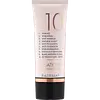What's inside
What's inside
 Key Ingredients
Key Ingredients

 Benefits
Benefits

 Concerns
Concerns

 Ingredients Side-by-side
Ingredients Side-by-side

Water
Skin ConditioningDimethicone
EmollientPolysilicone-11
Glycerin
HumectantEthylhexyl Methoxycinnamate
UV AbsorberNiacinamide
SmoothingButylene Glycol
HumectantMica
Cosmetic ColorantButyl Methoxydibenzoylmethane
UV AbsorberOctocrylene
UV AbsorberSynthetic Fluorphlogopite
Bis-Ethylhexyloxyphenol Methoxyphenyl Triazine
Skin ConditioningTocopheryl Acetate
AntioxidantPolyacrylamide
C13-14 Isoparaffin
EmollientIsohexadecane
EmollientPPG-26-Buteth-26
Skin ConditioningPolyglyceryl-4 Isostearate
EmulsifyingZingiber Officinale Root Extract
MaskingCetyl PEG/PPG-10/1 Dimethicone
EmulsifyingPEG-40 Hydrogenated Castor Oil
EmulsifyingAmmonium Polyacryloyldimethyl Taurate
Emulsion StabilisingHexyl Laurate
EmollientEthylhexylglycerin
Skin ConditioningDisodium EDTA
Laureth-7
EmulsifyingLaureth-12
EmulsifyingPolysorbate 80
EmulsifyingBHT
AntioxidantPolysorbate 20
EmulsifyingTin Oxide
AbrasivePhenoxyethanol
PreservativeParfum
MaskingCitronellol
PerfumingLinalool
PerfumingLimonene
PerfumingCitral
PerfumingCI 77491
Cosmetic ColorantCI 77492
Cosmetic ColorantCI 77499
Cosmetic ColorantCI 77891
Cosmetic ColorantWater, Dimethicone, Polysilicone-11, Glycerin, Ethylhexyl Methoxycinnamate, Niacinamide, Butylene Glycol, Mica, Butyl Methoxydibenzoylmethane, Octocrylene, Synthetic Fluorphlogopite, Bis-Ethylhexyloxyphenol Methoxyphenyl Triazine, Tocopheryl Acetate, Polyacrylamide, C13-14 Isoparaffin, Isohexadecane, PPG-26-Buteth-26, Polyglyceryl-4 Isostearate, Zingiber Officinale Root Extract, Cetyl PEG/PPG-10/1 Dimethicone, PEG-40 Hydrogenated Castor Oil, Ammonium Polyacryloyldimethyl Taurate, Hexyl Laurate, Ethylhexylglycerin, Disodium EDTA, Laureth-7, Laureth-12, Polysorbate 80, BHT, Polysorbate 20, Tin Oxide, Phenoxyethanol, Parfum, Citronellol, Linalool, Limonene, Citral, CI 77491, CI 77492, CI 77499, CI 77891
Water
Skin ConditioningButylene Glycol
HumectantMica
Cosmetic ColorantGlycerin
HumectantCaprylic/Capric Triglyceride
MaskingGlyceryl Stearate Se
EmulsifyingOctyldodecanol
EmollientSilica
AbrasivePentylene Glycol
Skin ConditioningCetearyl Alcohol
EmollientTriolein
Skin ConditioningMagnesium Aluminum Silicate
AbsorbentSalix Alba Bark Extract
AstringentGlyceryl Caprylate/Caprate
EmollientEnantia Chlorantha Bark Extract
Skin ConditioningGlyceryl Dioleate
EmollientXanthan Gum
EmulsifyingOleanolic Acid
Skin ConditioningWater, Butylene Glycol, Mica, Glycerin, Caprylic/Capric Triglyceride, Glyceryl Stearate Se, Octyldodecanol, Silica, Pentylene Glycol, Cetearyl Alcohol, Triolein, Magnesium Aluminum Silicate, Salix Alba Bark Extract, Glyceryl Caprylate/Caprate, Enantia Chlorantha Bark Extract, Glyceryl Dioleate, Xanthan Gum, Oleanolic Acid
 Reviews
Reviews

Ingredients Explained
These ingredients are found in both products.
Ingredients higher up in an ingredient list are typically present in a larger amount.
Butylene Glycol (or BG) is used within cosmetic products for a few different reasons:
Overall, Butylene Glycol is a safe and well-rounded ingredient that works well with other ingredients.
Though this ingredient works well with most skin types, some people with sensitive skin may experience a reaction such as allergic rashes, closed comedones, or itchiness.
Learn more about Butylene GlycolGlycerin is already naturally found in your skin. It helps moisturize and protect your skin.
A study from 2016 found glycerin to be more effective as a humectant than AHAs and hyaluronic acid.
As a humectant, it helps the skin stay hydrated by pulling moisture to your skin. The low molecular weight of glycerin allows it to pull moisture into the deeper layers of your skin.
Hydrated skin improves your skin barrier; Your skin barrier helps protect against irritants and bacteria.
Glycerin has also been found to have antimicrobial and antiviral properties. Due to these properties, glycerin is often used in wound and burn treatments.
In cosmetics, glycerin is usually derived from plants such as soybean or palm. However, it can also be sourced from animals, such as tallow or animal fat.
This ingredient is organic, colorless, odorless, and non-toxic.
Glycerin is the name for this ingredient in American English. British English uses Glycerol/Glycerine.
Learn more about GlycerinMica is a naturally occurring mineral used to add shimmer and color in cosmetics. It can also help improve the texture of a product or give it an opaque, white/silver color.
Serecite is the name for very fine but ragged grains of mica.
This ingredient is often coated with metal oxides like titanium dioxide. Trace amounts of heavy metals may be found in mica, but these metals are not harmful in our personal products.
Mica has been used since prehistoric times throughout the world. Ancient Egyptian, Indian, Greek, Roman, Aztec, and Chinese civilizations have used mica.
Learn more about MicaWater. It's the most common cosmetic ingredient of all. You'll usually see it at the top of ingredient lists, meaning that it makes up the largest part of the product.
So why is it so popular? Water most often acts as a solvent - this means that it helps dissolve other ingredients into the formulation.
You'll also recognize water as that liquid we all need to stay alive. If you see this, drink a glass of water. Stay hydrated!
Learn more about Water